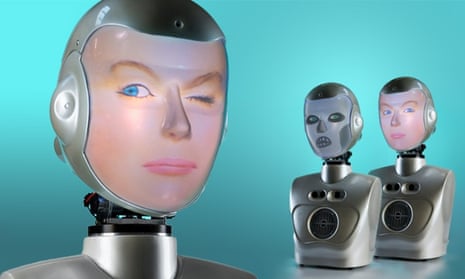If Skype and FaceTime aren't giving you enough of the human touch, you could soon be talking face to rubbery face with your loved ones, thanks to SociBot, a creepy “social robot” that can imitate your friends.
“It's like having a real presence in the room,” says Nic Carey, research co-ordinator at Engineered Arts, the Cornish company behind the device. “You simply upload a static photo of the face you want it to mimic and our software does the rest, animating the features down to subtle mouth twitches and eyes that follow you around the room. Even when they're not speaking, it really feels like there's someone there, keeping an eye on you.”
The face of a disembodied colleague staring out from a silvery helmet might not be what you'd expect at your average teleconference, but the company thinks it could transform the way we interact over long distances by simulating the subtleties of human expression, recreating the things that are lost on a flat screen.
Designed to be gender and ethnically neutral, the translucent mask is projected on from within, the chosen face 3D-mapped on to its surface and speech perfectly lip-synched, while the head turns and tilts as it talks.

While capable of mimicking others, the SociBot's slightly sinister side comes from the fact that it is also watching you. Equipped with two cameras in its head and a depth sensor in its chest, it can detect gestures and movements, as well as judge your emotions by mapping the position of your features over a series of internal templates.
“It knows when you're there and can tell how you're feeling, and it knows how to respond accordingly,” says Carey. “We've tried to make it as human as possible, down to the smallest details, like its pupils dilating when a new person comes into the room.”
The SociBot, which retails at £14,500, is a slimmed-down version of the company's RoboThespian, a full-sized all-singing all-dancing robot designed for visitor attractions. It contains the same technology as its older brother, only chopped off at the torso, while a mini-me version is also available for desktop use and “playing around with at home” – yours for £9,500.
The company sees its potential in shopping centres and theme parks, airports and tourist information centres, “anywhere requiring personalised content delivered with a human touch,” as well as potential security applications, given that the SociBot can track up to 12 people simultaneously, even in a crowd. So why not, um, employ a human instead?
“Robots don't handle unexpected situations terribly well, but they are good at doing repetitive tasks that are very boring for real people to do again and again,” says Carey. Hence the introduction of those holographic cut-out air hostesses telling you to remember your passport at the airport check-in and put your fluids in a plastic bag.
“The SociBot goes one step beyond that, by being able to interact with people,” adds Carey. “Human-robot interaction is a big research area. We are looking for platforms that can really be emotional, investigating how robots can interact with people on multiple levels.”
Already flashing its dilated pupils and twitching its mouth, will your social robot soon start drooling or blushing when you look at it? And what happens when its affections wander elsewhere? At least we can be thankful that it comes with an off switch. For now.

Comments (…)
Sign in or create your Guardian account to join the discussion